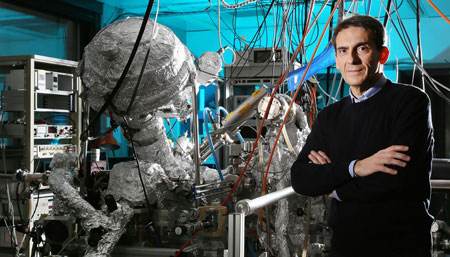| Posted: Dec 18, 2014 |
Electron spin could be the key to high-temperature superconductivity
|
|
(Nanowerk News) EPFL scientists take a significant step in our understanding of superconductivity by studying the strange quantum events in a unique superconducting material.
|
|
Cuprates are materials with great promise for achieving superconductivity at higher temperatures (-120°C). This could mean low-cost electricity without energy loss. Intense research has focused on understanding the physics of cuprates in the hope that we can develop room-temperature superconductors. EPFL scientists have now used a cutting-edge technique to uncover the way cuprates become superconductors. Their work is published in Nature Communications ("Anisotropic softening of magnetic excitations along the nodal direction in superconducting cuprates").
|
 |
| Marco Grioni
|
|
Conventional superconductors are materials that conduct electricity with no electrical resistance under temperatures nearing absolute zero (-273.15°C or 0 Kelvin). Under these conditions, the electrons of the material join up and form electron couples that are called “Cooper pairs”, and in this form can flow without resistance. Generally, cooper pairs form at such low temperatures, and only when the superconductor’s atoms vibrate and create an attractive force between electrons.
|
|
However, there is a class of superconductors where Cooper pairs do not form because atoms nudge them together. These superconductors are copper-based materials called “cuprates”, and in normal temperatures they are actually electrical insulators and magnets.
|
|
The popularity of cuprates comes from the fact that they become superconductors at much higher temperatures than other materials: just over -123.15°C (150 Kelvin). This makes cuprates an excellent way towards everyday superconductivity. However, previous studies have suggested that cuprates do not become superconducting like other materials, which poses the question: how does superconductivity arise in cuprates?
|
|
A team of researchers led by Marco Grioni at EPFL has used a cutting-edge spectroscopic technique to explore the unique superconductivity of cuprates. The scientists used a technique called Resonant Inelastic X-ray Scattering, which is used to investigate the electronic structure of materials. This high-resolution method was able to monitor what happens to the electrons of a cuprate sample as it turned into a superconductor.
|
|
“Normally, superconductors hate magnetism,” says Grioni. “Either you have a good magnet or a good superconductor, but not both. Cuprates are very different and have really surprised everyone, because they are normally insulators and magnets, but they become superconducting when a few extra electrons are added by gently tweaking its chemical composition.”
|
|
The key ingredient of magnetism is a property of electrons called spin, which can be thought of as the moment of a spinning top. Spins can interact with each other and create spin waves that travel across the material. When magnetic materials are disturbed, spin waves are created and spread in ripples throughout their volume. Such spin waves are telltale fingerprints of the magnetic interaction and structure.
|
|
Even when they become superconducting, cuprates do not lose their magnetic properties. “Something of the magnet remains in the superconductor, and could play a major role in the appearance of superconductivity ” says Grioni. “The new results give us a better idea of how the spins interact in these fascinating materials.”
|
|
The findings propose a novel understanding of superconductivity in cuprates, and possibly in other high-temperature superconductors. By revealing the role of spin interactions, it might pave the way for bringing high-temperature superconductors into the real world.
|

